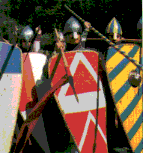
Northallerton

22nd August 1138
This battle occurred during a period in England known as 'the anarchy'. Popularised by the Cadfael book and TV series there was a number of vicious rebellions and civil wars which raged throughout the rule of the unfortunate King Stephen.
Stephen was fighting for the crown against his sister Matilda, who preferred to be called 'The Empress Maude'.
The Scottish King David was also the maternal uncle of Matilda, following many border incursions he decided to invade in force, partly to assist his niece but mainly in an attempt to annex Northumberland.
This in fact lead the way for many Scottish invasions which mainly occurred when the English king would be engaged elsewhere. As Henry VIII would find out.
Bizarrely the leader of the English defence was to be the ageing and bedridden Thurstan Archbishop of York. However this turned out not to be a bad choice. He offered heavenly rewards for those who joined the army and eternal damnation for those that did not! He also provided the banners of four Yorkshire saints which were mounted on ships masts and raised above the English lines. This gave the battle it's popular name, "The battle of the Standard". it also proved to be an inspired recruiting tool as Saxons and Normans alike flocked to the banners.
The battle was a relatively short one. The galwegians (men from Galloway) had felt slighted by the Scottish king's attempt to place them in the rear ranks, so that better armoured men could take the front ranks. At the order to attack these men charged the English lines.
However the English had drawn up their armoured men in the front ranks. Still with their distinctive 'tear shaped' Norman shield. behind them were the archers (the long bow lay in the future). The archers inflicted serious damage on the lightly armoured Scots.
A cavalry charge but a Scottish Prince very nearly won the day, but in a classic 'ruse de guerre' an Englishman held aloft the head of one of the many dad and shouted that King David was dead. Scottish moral plummeted and their army fled. Only gallant resistance from the king's personal guard let him escape. Northumberland remained English.
Neville's Cross
17th October 1346
Thirteen years after the English victory at Hallidon Hill the Scots were once again fighting in England.
This time it was a more familiar theme that led to invasion, a Scottish alliance with France.
Edward III was fighting in France for the French crown.
| King David II of Scotland seized the opportunity to invade. At the head of 15,000 Scots he marched south into England, where he was met by just under 11,000 Englishmen under the command of Sir Ralph de Neville and Henry de Percy. the armies met just north of Durham. |
|
Sir William Douglas and 500 Scots were busy plundering the nearby town of Merrington when out of the mist came the English army. Completely surprised and outnumbered they attempted to get back to their own army, less than half made it.
Alerted the Scottish King made his dispositions sending the earl of Moray into the attack.
The English were deployed on a narrow ridge with archers and infantry deployed to the front. the cavalry were left at the rear due to the unsuitable nature of the terrain.
Moray attacked the English left and was immediately in trouble with the English archers making nearly every arrow count. On the right the Scots fared better but the arrival of the English cavalry drove them back.
King David himself was captured, spending the next 11 years in captivity. He was joined there by the king of France who had also been defeated by the English.